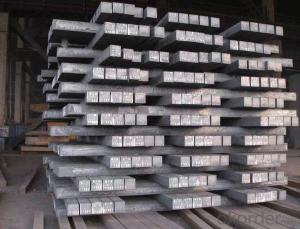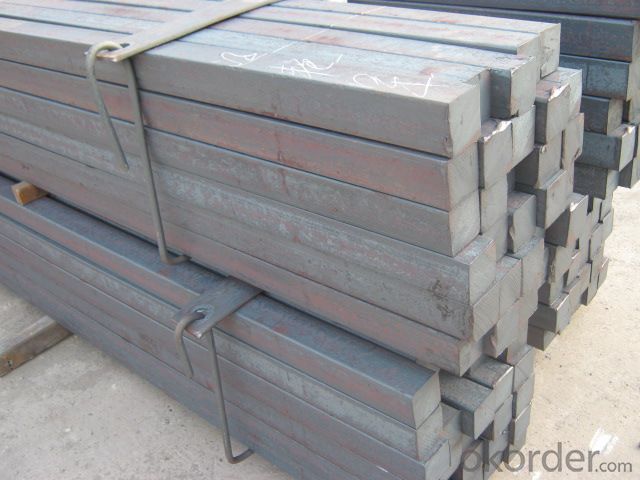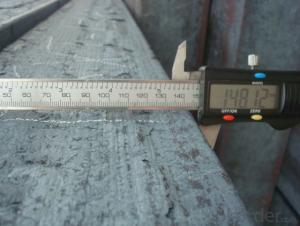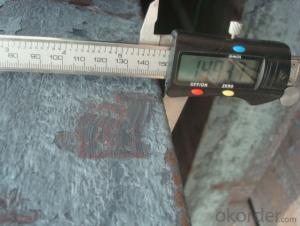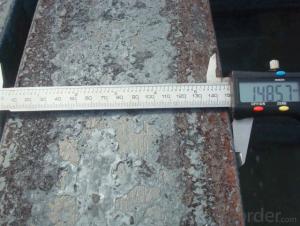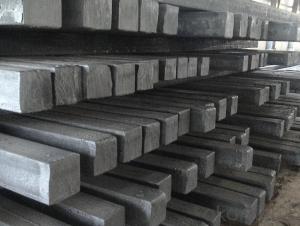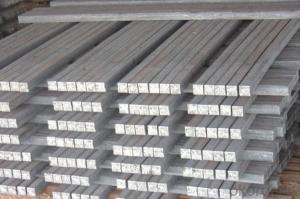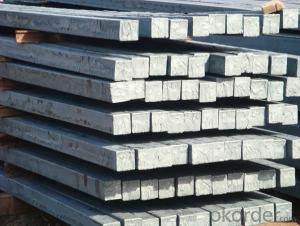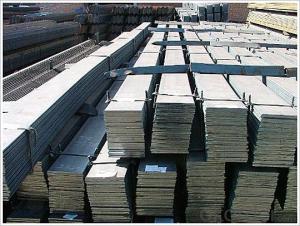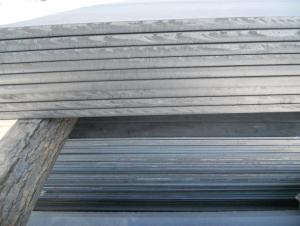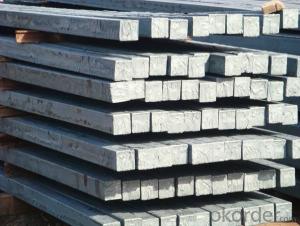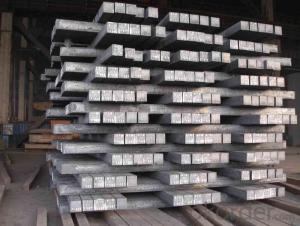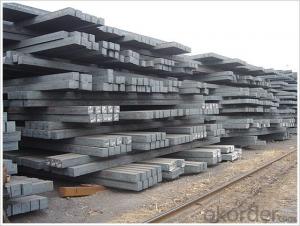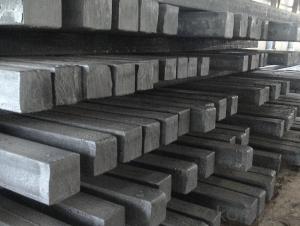Raw Material Steel Rectangle Billet Bars
- Loading Port:
- China main port
- Payment Terms:
- TT OR LC
- Min Order Qty:
- 100 m.t.
- Supply Capability:
- 100000 m.t./month
OKorder Service Pledge
OKorder Financial Service
You Might Also Like
Range of thickness: 150-240 - mm +/- 5 mm width range: 880-1530 - mm +/- 20 mm
Length: 3700-10000 - mm +/- 500 - mm
Cross-sectional size: 64 * 64; 82 * 82; 98 * 98; 124 * 124; 120 * 150; 152 * 164; 152 * 170 mm
Length: 9000 mm
Section of tolerance: billet: 1.0 +/- 2.0-1.0 +/- 1.0 mm slab: width: +/- 2.0 mm thickness: +/- 3.0 mm
The length tolerance: +/- 200 mm
Section diagonal tolerance: 3.5-8.0 MM
Billet section size protrusions requirements: < 1242 mm, do not allow; > = 1242 mm, < = 2 mm 1242 mm, < = 3 mm
Beheading (shear) extension deformation: < 1242 mm billet: no control; The slab: < = 15 mm
Surface tilt: no more than billet section 0.1
Bending: every 1 m length is not more than 10 mm.
Notes:
1, The theoretical weights in the list, base on the density of 7.85 g/cm3.
2, Formula for theoretical weight of Square bar: (length of a side)2 * 0.00785
3, The numbers with *mean that they are not regular or we don’t offer them.
-Regular length of Square Bar:
Steel | Length of a side (mm) | Length of steel (m) |
Normal steel | < 25 | 4~10 |
> 25 | 3~9 | |
Steel of high quality | All measure | 2~6 |
Tool steel >75 | 1~6 |
Usage/Applications
-The Square Bar is normally used as structure steel.
-Row material for other structure steel like steel angles, channels, I-beams, H-beams, etc…
Packaging & Delivery
-Packing Detail: The products can be packed in bundles by steel wires.
-Marks: We make tag marks and color marks. The tag marks with white background and red company logo will be tied up to each bundle of the products. The information is usually including basic information of products and company and other information requested by customers. As for color marks, we will paint both ends of bundles to make sure that it will be more convenient for customers to distinguish them from other products.
-Delivery Detail: 30~45 working days after receive buyer’s T.T. or L/C.
Transportation
-The products can be delivered by bulk vessel or by container. As for container, products with the length of 6m will be loaded in 20’ container, with 9m or 12m, in 40’ container.
-The maximum quantity of loading of container is 25 tons.
-The products are usually transported to the nearest port from the production place.
- Q: What is the role of steel billets in the manufacturing of construction cranes?
- Steel billets play a crucial role in the manufacturing of construction cranes as they serve as the raw material for the production of various crane components. These billets are essentially semi-finished steel products that are cast into a specific shape and size, usually in a rectangular or square form. One of the primary uses of steel billets in crane manufacturing is for the production of structural members such as beams, columns, and braces. These components provide the necessary strength and stability to support the weight of the crane and the loads it carries. Steel billets are chosen for their high strength and durability, allowing the crane to withstand heavy loads and adverse working conditions. Moreover, steel billets are also used to manufacture the boom, jib, and other lifting mechanisms of the crane. These components are subjected to significant stress and forces during crane operation, and steel billets' superior mechanical properties make them ideal for ensuring the structural integrity and longevity of the crane. Additionally, steel billets are utilized in the fabrication of the crane's counterweights. Counterweights are essential to balance the weight of the load being lifted and prevent the crane from tipping over. By using steel billets, manufacturers can produce counterweights that are heavy enough to counterbalance the loads without compromising the overall stability and safety of the crane. Furthermore, steel billets are often used in the production of other crane parts such as pins, bolts, and connectors. These small but critical components contribute to the overall performance and functionality of the crane, ensuring smooth operation and structural integrity. Overall, steel billets serve as the building blocks for the manufacturing of construction cranes, providing the necessary strength, durability, and stability required for these heavy-duty machines. Without steel billets, it would be nearly impossible to produce cranes capable of lifting heavy loads and withstanding the demanding conditions of construction sites.
- Q: How are steel billets packaged for shipment?
- Steel billets are packaged in a manner that guarantees their protection and facilitates convenient handling for shipment. The packaging process involves multiple steps to ensure the safe transportation of the billets. First and foremost, the steel billets undergo inspection to ensure that they meet the required quality standards. Upon approval, they are cleaned and dried to eliminate any dirt or moisture that may cause corrosion during shipment. Following that, the billets are bundled together using steel strapping or wire to secure them in a compact form. This bundling not only prevents the billets from shifting or rolling during transportation but also makes it easier to handle and load them onto trucks or containers. Additionally, to provide further protection, the steel billets are often wrapped in a layer of plastic or paper. This extra layer acts as a barrier against moisture, dust, and other potential contaminants that could harm the billets during transit. Once the billets are bundled and wrapped, they are typically loaded onto pallets or placed in steel crates. This ensures stability during transportation and allows for ease of movement and stacking using forklifts or cranes. Lastly, the packaged steel billets are labeled with relevant information such as the product name, dimensions, weight, and destination. This labeling guarantees accurate identification and aids in the efficient handling and delivery of the billets. In summary, steel billets are packaged for shipment with a focus on protection, ease of handling, and efficient transportation. These packaging measures guarantee that the billets arrive at their destination in optimal condition, ready for further processing or utilization in various industries.
- Q: What are the different methods of steel billet casting?
- There are several different methods of steel billet casting that are commonly used in the industry. These methods include continuous casting, ingot casting, and direct casting. Continuous casting is the most widely used method of steel billet casting. In this process, molten steel is poured into a water-cooled mold, which is usually made of copper. As the steel solidifies, a continuous billet is formed, which is then cut into desired lengths. Continuous casting allows for a high production rate and precise control over the dimensions and quality of the billets. Ingot casting is another method of steel billet casting, which involves pouring molten steel into individual molds to create ingots. These ingots are then allowed to solidify before being reheated and hot rolled into billets. Ingot casting is commonly used for small-scale production or for specialty steel alloys that require specific compositions. Direct casting, also known as strand casting, is a newer method of steel billet casting that eliminates the need for solidification and reheating processes. In this method, molten steel is directly cast into billets through a series of water-cooled copper molds. The billets are then cooled and cut to the desired lengths. Direct casting offers advantages such as reduced energy consumption and improved yield, as it eliminates the intermediate steps of ingot casting. Overall, the choice of steel billet casting method depends on factors such as production volume, desired quality, and specific requirements of the steel alloy being produced. Each method has its own advantages and limitations, and the selection of the appropriate method is crucial for ensuring efficient and cost-effective steel billet production.
- Q: What are the potential applications of steel billets in the automotive industry?
- Steel billets have a wide range of potential applications in the automotive industry due to their exceptional strength and durability. One key application is in the manufacturing of automotive components such as engine blocks, crankshafts, and transmission parts. These components require a material that can withstand high temperatures, heavy loads, and repetitive stress, which steel billets provide. Another important application is in the production of chassis and body panels. Steel billets are often used to create the structural framework of a vehicle, providing the necessary strength and rigidity to ensure safety and stability. Additionally, steel billets can be formed into various shapes and sizes, allowing for the customization of chassis components to meet the specific requirements of different vehicle models. Steel billets are also utilized in the production of suspension systems and steering mechanisms. These parts require a material that can absorb vibrations, dampen shocks, and provide precise control. Steel billets possess these properties, making them an ideal choice for these critical automotive components. Furthermore, steel billets find applications in the production of exhaust systems, as they can withstand high temperatures and corrosive environments. The ability of steel to resist rust and corrosion ensures the longevity of the exhaust system, contributing to the overall performance and efficiency of the vehicle. In summary, the potential applications of steel billets in the automotive industry are vast. From engine components to chassis parts, suspension systems to exhaust systems, steel billets provide the strength, durability, and versatility required to meet the demanding needs of the automotive sector.
- Q: How do steel billets contribute to the overall fire resistance of a structure?
- The overall fire resistance of a structure is enhanced by steel billets in several ways. Firstly, steel billets are made of a non-combustible material, meaning they cannot burn or aid in the spread of fire. By incorporating steel billets into a building's construction, the risk of fire propagation is significantly reduced. Secondly, steel possesses a high melting point, typically around 1370 degrees Celsius. This characteristic enables steel to maintain its structural integrity and resist deformation even under intense heat. By using solid steel blocks, known as steel billets, the structure gains strength and stability that can withstand the impact of a fire. Moreover, steel exhibits low thermal conductivity, resulting in poor heat conduction. This property helps to slow down the transfer of heat from the fire to the surrounding areas of the structure. By acting as a barrier, steel billets hinder rapid temperature rise, allowing occupants more time to evacuate and firefighters more time to extinguish the fire. Furthermore, steel billets are frequently utilized in constructing fire-resistant walls or barriers within a structure. These walls are designed to compartmentalize the building, confining the spread of fire and smoke to specific areas. By incorporating steel billets into these fire-resistant walls, the overall construction becomes more durable and capable of enduring the extreme conditions of a fire. In conclusion, steel billets play a crucial role in enhancing the overall fire resistance of a structure due to their non-combustible nature, high melting point, low thermal conductivity, and ability to reinforce fire-resistant walls. By incorporating steel billets into the construction process, buildings can achieve greater resilience against fire incidents, ensuring the safety of occupants and minimizing fire damage.
- Q: How are steel billets used in the manufacturing of medical equipment?
- Steel billets are used in the manufacturing of medical equipment as a raw material that can be shaped and machined into various components such as surgical instruments, implants, and medical device casings. The high strength and durability of steel make it suitable for producing equipment that requires precision, reliability, and resistance to corrosion.
- Q: How do steel billets contribute to the manufacturing of renewable energy equipment?
- Steel billets are an essential component in the manufacturing of renewable energy equipment, such as wind turbines and solar panels. These billets are used to create sturdy and durable structures, including tower bases for wind turbines and frames for solar panels. Additionally, steel billets are crucial in the production of transmission and distribution infrastructure required for renewable energy systems. Their strength and versatility make them an indispensable material in the renewable energy industry, enabling the efficient and reliable generation of green energy.
- Q: What are the main factors affecting the dimensional stability of steel billets?
- The dimensional stability of steel billets can be influenced by various factors. These factors include temperature, cooling rate, composition, mechanical stresses, heat treatment, and manufacturing techniques. Firstly, temperature plays a significant role in the dimensional stability of steel billets. Depending on the temperature they are exposed to, the billets can undergo thermal expansion or contraction. To minimize dimensional changes, it is important to carefully control the temperature during the manufacturing process and subsequent cooling stages. Secondly, the rate at which the steel billets cool down after being heated also affects their dimensional stability. Rapid cooling can result in internal stresses and cause warping or distortion, while slow cooling can lead to uneven dimensional changes. Thirdly, the chemical composition of the steel billets is a crucial factor. Different alloying elements, impurities, and carbon content can influence the behavior of the material during heating and cooling. Higher carbon content, for example, increases the likelihood of warping or distortion. Moreover, mechanical stresses from handling, transportation, or machining processes can impact the dimensional stability of steel billets. Excessive bending, twisting, or pressure can cause permanent deformation or residual stresses, thus affecting overall dimensional stability. Furthermore, the heat treatment process also plays a role in the dimensional stability of steel billets. Different heat treatment methods can introduce internal stresses or phase transformations that may alter the billet's dimensions. Lastly, the manufacturing techniques used during the production of steel billets can have an impact on their dimensional stability. Inadequate control or inconsistencies in casting, rolling, or forging processes can result in variations in the billet's dimensions. Considering and controlling these factors is crucial to ensure the dimensional stability of steel billets. Any dimensional changes can have consequences for subsequent processing steps and the overall quality of the final product.
- Q: What are the main factors affecting the mechanical properties of steel billets?
- The mechanical properties of steel billets can be influenced by several main factors. 1. The chemical composition of steel, including the levels of carbon, alloying elements, and impurities, plays a crucial role in determining its mechanical properties. Higher carbon content typically leads to increased strength but decreased ductility. Alloying elements like manganese, nickel, and chromium can enhance specific properties such as hardness, toughness, or corrosion resistance. 2. The mechanical properties of steel billets can be greatly influenced by the heat treatment process. This process involves controlled heating and cooling of the billets. Various heat treatment methods, such as annealing, quenching, and tempering, can modify the microstructure and subsequently impact the hardness, strength, and toughness of the steel. 3. The microstructure of steel, which is determined by the cooling rate during solidification or heat treatment, is another significant factor. The presence of different phases, grain size, and distribution of alloying elements within the microstructure can have a significant impact on the mechanical properties of the steel. 4. The manufacturing process used to produce steel billets also affects their mechanical properties. Factors like the casting method, rolling or forging techniques, and the presence of defects or impurities introduced during production can influence the final properties of the billets. 5. Temperature is a crucial factor that influences the mechanical properties of steel. It can affect the strength, ductility, and toughness of the material. For example, as the temperature decreases, steel tends to become more brittle, while at elevated temperatures, it may exhibit reduced strength and increased ductility. 6. The strain rate, which refers to the rate at which a load is applied to the steel billets, can also impact their mechanical properties. High strain rates, such as those experienced during rapid impact or dynamic loading, can result in different behavior and failure mechanisms compared to slower or static loading conditions. It is important to note that these factors are interconnected, and changes in one factor can influence others. This complex interaction can lead to a wide range of possible mechanical properties for steel billets.
- Q: How do steel billets contribute to the overall safety of a product?
- Steel billets contribute to the overall safety of a product by providing a strong and durable foundation. They are used as raw material in the manufacturing of various products, including construction materials, automotive parts, and machinery. The high strength and structural integrity of steel billets ensure that the end products are able to withstand heavy loads, extreme conditions, and potential hazards, thus enhancing safety and reliability.
Send your message to us
Raw Material Steel Rectangle Billet Bars
- Loading Port:
- China main port
- Payment Terms:
- TT OR LC
- Min Order Qty:
- 100 m.t.
- Supply Capability:
- 100000 m.t./month
OKorder Service Pledge
OKorder Financial Service
Similar products
Hot products
Hot Searches
Related keywords
